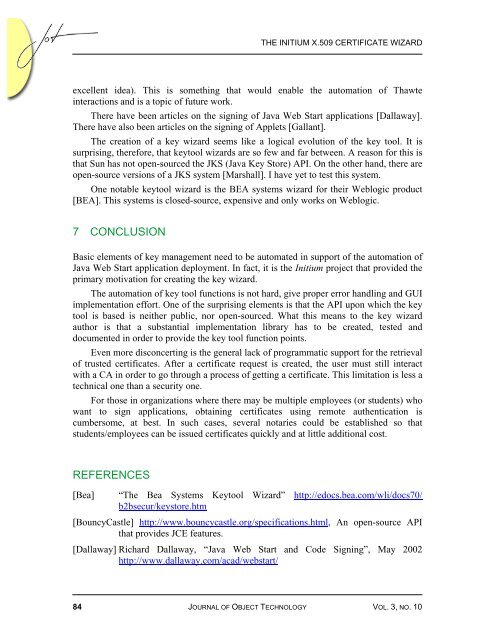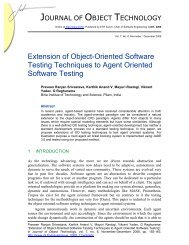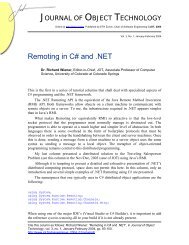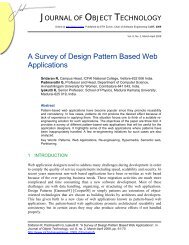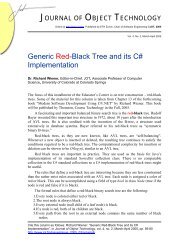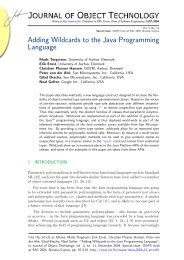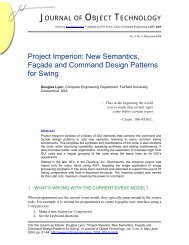The Initium X.509 Certificate Wizard - The Journal of Object ...
The Initium X.509 Certificate Wizard - The Journal of Object ...
The Initium X.509 Certificate Wizard - The Journal of Object ...
Create successful ePaper yourself
Turn your PDF publications into a flip-book with our unique Google optimized e-Paper software.
THE INITIUM <strong>X.509</strong> CERTIFICATE WIZARD<br />
excellent idea). This is something that would enable the automation <strong>of</strong> Thawte<br />
interactions and is a topic <strong>of</strong> future work.<br />
<strong>The</strong>re have been articles on the signing <strong>of</strong> Java Web Start applications [Dallaway].<br />
<strong>The</strong>re have also been articles on the signing <strong>of</strong> Applets [Gallant].<br />
<strong>The</strong> creation <strong>of</strong> a key wizard seems like a logical evolution <strong>of</strong> the key tool. It is<br />
surprising, therefore, that keytool wizards are so few and far between. A reason for this is<br />
that Sun has not open-sourced the JKS (Java Key Store) API. On the other hand, there are<br />
open-source versions <strong>of</strong> a JKS system [Marshall]. I have yet to test this system.<br />
One notable keytool wizard is the BEA systems wizard for their Weblogic product<br />
[BEA]. This systems is closed-source, expensive and only works on Weblogic.<br />
7 CONCLUSION<br />
Basic elements <strong>of</strong> key management need to be automated in support <strong>of</strong> the automation <strong>of</strong><br />
Java Web Start application deployment. In fact, it is the <strong>Initium</strong> project that provided the<br />
primary motivation for creating the key wizard.<br />
<strong>The</strong> automation <strong>of</strong> key tool functions is not hard, give proper error handling and GUI<br />
implementation effort. One <strong>of</strong> the surprising elements is that the API upon which the key<br />
tool is based is neither public, nor open-sourced. What this means to the key wizard<br />
author is that a substantial implementation library has to be created, tested and<br />
documented in order to provide the key tool function points.<br />
Even more disconcerting is the general lack <strong>of</strong> programmatic support for the retrieval<br />
<strong>of</strong> trusted certificates. After a certificate request is created, the user must still interact<br />
with a CA in order to go through a process <strong>of</strong> getting a certificate. This limitation is less a<br />
technical one than a security one.<br />
For those in organizations where there may be multiple employees (or students) who<br />
want to sign applications, obtaining certificates using remote authentication is<br />
cumbersome, at best. In such cases, several notaries could be established so that<br />
students/employees can be issued certificates quickly and at little additional cost.<br />
REFERENCES<br />
[Bea] “<strong>The</strong> Bea Systems Keytool <strong>Wizard</strong>” http://edocs.bea.com/wli/docs70/<br />
b2bsecur/keystore.htm<br />
[BouncyCastle] http://www.bouncycastle.org/specifications.html, An open-source API<br />
that provides JCE features.<br />
[Dallaway] Richard Dallaway, “Java Web Start and Code Signing”, May 2002<br />
http://www.dallaway.com/acad/webstart/<br />
84 JOURNAL OF OBJECT TECHNOLOGY VOL. 3, NO. 10


